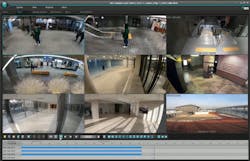How smart retail video solutions drive profitability and growth
The Skinny
- Enhanced Customer Insights: Smart video solutions provide detailed analytics on customer behavior, helping retailers understand shopping patterns, optimize store layouts, and improve customer experiences.
- Loss Prevention and Security: Advanced video analytics help in identifying and preventing theft, fraud, and other security issues, thereby reducing losses and enhancing overall store security.
- Operational Efficiency: By automating various processes such as inventory management and staff allocation, smart video solutions contribute to more efficient store operations and cost savings.
Video surveillance has long been essential to brick-and-mortar branch retail operations and key to ensuring the security and safety of people and assets. But now, thanks to the emergence of artificial intelligence (AI)-enabled video analytics, camera systems are no longer just a tool to deter and investigate crime. They are adding new value and helping to build profits while reducing losses.
Smart video is becoming a multifaceted solution, one that’s being used to drive operational efficiency, enhance customer experience, and boost profitability. By leveraging the accelerating power of AI technologies, U.S. retailers are pivoting to address a wider set of challenges, to reduce costs, grow sales, enhance safety, and stay ahead in a competitive market.
The emergence and adoption of this new technology is certainly timely, as the retail sector is facing multiple threats to profitability. Today’s challenges include not only organized retail crime (ORC) but also opportunistic theft, which could worsen with rising inflation and unemployment. Additionally, retailers face increasing real estate and labor costs, stiff competition from e-commerce leaders, and shifting consumer behaviors.
The new applications and benefits of AI-powered surveillance systems have never been more essential.
Recent data from the National Retail Federation (NRF) indicates that inventory loss has become a nearly $100 billion annual problem. The NRF also highlights the need for state and federal law makers to address the growing problem of ORC activity, and there are calls for retailers and law enforcers to work more closely to ensure that shop theft is always reported and recorded accurately.
More effective video surveillance, with better scene capture and robust storage, will undoubtedly help with this, but retailers are also looking for added value to further justify their investments. This is particularly the case in locations where store owners are less confident that police will provide a rapid response.
In these areas, investments in conventional security measures will take longer to deliver a return on investment, so it should come as no surprise that retailers are seeking more capable surveillance solutions that go beyond loss prevention and add value in other ways.
Adoption of High-Performance Cameras and Advanced AI-Powered Analytics
This is already unfolding, with advances in video surveillance technology — ranging from high-performance cameras to powerful AI analytics and seamless integration with retail systems like point-of-sale, inventory management, and enterprise resource planning (ERP) — creating new opportunities to enhance scalability and drive profitability.
Retail chains are already benefitting from advanced, multi-function video solutions, including some major brands, across the U.S., and globally. In analyzing these applications and anticipating the next wave of innovations, here are some of the key ways retailers are maximizing the value of their camera systems to enhance security, efficiency, and profitability. With simple, phased migration options, these key points apply to both new systems, and to existing system upgrades.
We have seen that by reducing losses, a well-designed and cost-effective video solution can deliver a full return on investment within a year or two — and in some cases, even faster.
But today, the benefits extend far beyond that. The latest advances in video technology can help to build profits, not just protect them, by giving store owners and managers more detailed, more granular, and — crucially — more actionable data.
Influencing Customer Behavior With Data-Driven Decisions
Profitability can be driven by influencing customer behaviors: by changing store layouts and designs; by enhancing in-store experiences; by better targeting promotions and displays; and by allocating staffing resources more responsively.
Successful retailers and branch managers have always done these things, using their experience, instinct, and observation. But the latest innovations in video technology — accelerated by AI — are delivering new layers of insight and allowing more proactive, certain and consistent decision making. For remote management this is particularly useful.
One clear example is heatmaps, which reveal at-a-glance how customers move through stores and around displays, where they spend most of their time, what catches their attention, and what they ignore. Heatmaps also show how behaviors can vary, depending on the time of day, or day of the week.
People counting and automated crowd density analysis can help to optimize staff/customer ratios, to get the balance right, ensuring that customers are not kept waiting and that staff are fully utilized. These analytics can be used in real-time to make operations more responsive to changing customer flow, especially in larger stores, where rostering is more complex. They can also be used in review, to reveal occupancy trends and help with future planning.
Again, these are things that successful retail operations have always done, but AI video is eliminating previously siloed systems and removing some of the reliance on guesswork and instinct to allow greater consistency.
Underpinning Expansion Strategies With Video Solutions
This is proving particularly valuable in large branch retail operations, where store owners, often one step removed from daily activities on nationally dispersed shop floors, must rely on the effectiveness of local branch managers and legacy retail data. Today, local managers can be better supported and empowered with highly accurate, actionable data from intuitive dashboards that show in-store and customer behaviors that don’t put a burden on staff training.
As a result, new video tech strategies are being adopted by branch retail operations to support their efforts to build profitability and to expand. This approach depends on improved integrated system capabilities, great value, and repeatability.
Integrated System Capabilities
Retailers ambitious for growth are innovating in the way they make use of today’s more powerful video analytics data. In addition, they are leveraging more seamless and cost-effective ways to integrate video with their wider data systems to deliver additional benefits.
In the past, many retailers struggled to connect their legacy retail systems with newer surveillance technology. But encoders provide a practical answer by digitizing data from point-of-sale and overlaying data on video, so it can be monitored and stored on NVRs and viewed, used, and analyzed in high resolution.
Using the same approach, log collectors can now feed video analytics data into wider ERP and inventory management systems. Not only does this mean that stores have the stock they need and head office staff gain complete oversight across their branch networks, but they can also improve a better understanding of customer behavior.
This can help them meet the increasing expectations of a personalized shopping experience. By leveraging AI data retailers, retailers can tailor promotions by individual store or region, offer curbside pickup, or a seamless hybrid model by mixing traditional brick and mortar retail with e-commerce, as and when it becomes a profitable proposition.
Targeting Better Value and Repeatability
The two other key objectives for retailers are: optimizing system value, and gaining the benefits of repeatability.
Value, as measured over the full lifetime of the system (i.e. TCO, or total cost of ownership) is affected by many factors, of which the most important are: device durability; ease and speed of installation; minimized operating and maintenance costs (for example, avoiding license fees and hidden costs sometimes associated with VMS operating platforms with federated architectures); reduced waste (e.g. by retaining and re-using existing infrastructure where possible); and optimized surveillance coverage with the most efficient, application-appropriate cameras.
For example, high performance fisheye and multi-sensor cameras that give full scene coverage in ultra-HD can replace three or four conventional fixed-lens cameras, enabling savings to be achieved not just from buying fewer cameras, but from faster installation, reduced cabling and infrastructure, and reduced maintenance.
These cameras also support frequent layout changes, seasonal displays and different shelving configurations, without creating blind spots or the need to constantly adjust camera positioning.
Leveraging Benefits for Branch Expansion
Meanwhile, repeatability is particularly relevant to branch retail operations that have growth strategies based on replicating store sizes and layouts. For these businesses, if a solution is deployed successfully in one branch, the most cost-effective answer is to repeat it across the whole business. This not only ensures best value at the installation stage, but it also underpins efficient procurement, ease-of-use and operating efficiency.
It’s also good news for retailers that operate a franchise model. A franchisee licensed to operate a branded outlet is authorized to use proprietary knowledge including cost-effectively implementing the same AI surveillance set-up to reap the same benefits. When replicated across multiple stores all these factors — including the new AI data capabilities, combined with cost efficiencies — become a force multiplier, adding value and boosting profits.
About the Author

Jason Burrows
Senior Sales Director
Jason Burrows is a Senior Sales Director at IDIS Americas, where he directs sales operations in North America. Burrows has been in the security industry for more than 30 years and has held key positions with the largest brands in video surveillance manufacturing and distribution.
